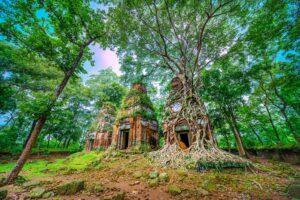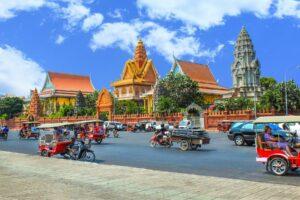Fodor's Expert Review Angkor Temple Complex
The temples of Angkor, hailed as "the eighth wonder of the world" by some, constitute the world's great ancient sites and Southeast Asia's most impressive archaeological treasure. The massive structures, surrounded by tropical forest, are comparable to Central America's Mayan ruins—and far exceed them in size. Angkor Wat is the world's largest religious structure—so large that it's hard to describe its breadth to someone who hasn't seen it. And that's just one temple in a complex of hundreds. In all, there are some 300 monuments reflecting Hindu and Buddhist influence scattered throughout the jungle, but only the largest have been excavated and only a few of those reconstructed. Most of these lie within a few miles of each other and can be seen in one day, though two or three days will allow you to better appreciate them.
Most people visit the temples of Bayon and Baphuon, which face east, in the morning—the earlier you arrive, the better the light and the smaller the crowd—and... READ MORE
The temples of Angkor, hailed as "the eighth wonder of the world" by some, constitute the world's great ancient sites and Southeast Asia's most impressive archaeological treasure. The massive structures, surrounded by tropical forest, are comparable to Central America's Mayan ruins—and far exceed them in size. Angkor Wat is the world's largest religious structure—so large that it's hard to describe its breadth to someone who hasn't seen it. And that's just one temple in a complex of hundreds. In all, there are some 300 monuments reflecting Hindu and Buddhist influence scattered throughout the jungle, but only the largest have been excavated and only a few of those reconstructed. Most of these lie within a few miles of each other and can be seen in one day, though two or three days will allow you to better appreciate them.
Most people visit the temples of Bayon and Baphuon, which face east, in the morning—the earlier you arrive, the better the light and the smaller the crowd—and west-facing Angkor Wat in the late afternoon, though this most famous of the temples can also be a stunning sight at sunrise. The woodland-surrounded Ta Prohm can be visited any time, though it is best photographed when cloudy, whereas the distant Banteay Srei is prettiest in the late-afternoon light. With so many temples to see, the choice is yours.
The entrance to the complex is 4 km (2½ miles) north of Siem Reap; you’ll need to arrange transportation to get here and around. Most independent travelers hire a car and driver ($35 to $50 per day), moto (motorcycle) driver ($12 to $18), or tuk-tuk ($20 to $35, seats up to four). Renting bicycles ($3 to $5) or electric bikes ($5 to $8) is also an option if you’re up for the exertion in the heat. Tourists may not drive motorized vehicles in the park. If you hire a driver, he’ll stick with you for the whole day. Going with a guide is strongly recommended.
The Angkor complex is open from 5:30 am to 6 pm. You’ll receive a ticket with your photo on it, which you’ll need at each site and to access the restrooms. If you buy your ticket at 5 pm, you'll be admitted for the remaining open hour, in time to see the sunset from Phnom Bakeng to catch the last rays setting Angkor Wat aglow. Your ticket will also count for the following day.
Consider swinging back to Siem Reap for lunch or to your hotel for an afternoon rest so you don't get templed out. Make sure to drink plenty of water.
READ LESS








